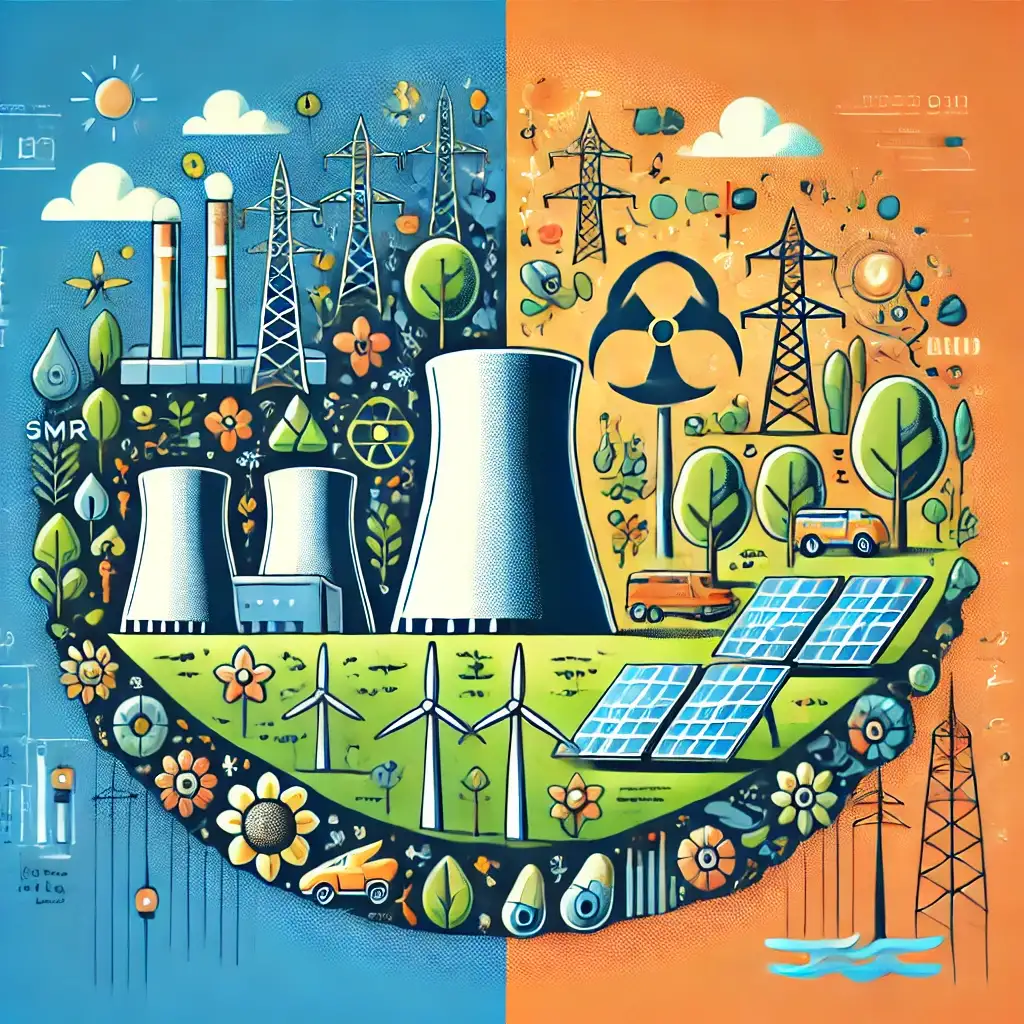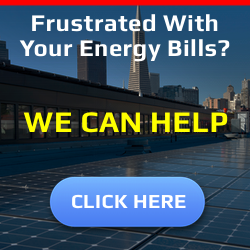In today’s world, the demand for clean, reliable, and scalable energy solutions has never been greater. We are transitioning from fossil fuels to more sustainable options. These include Small Modular Reactors (SMRs) and renewable energy sources like solar, wind, and geothermal. These options are emerging as key players in the global shift toward low-carbon energy. SMRs offer compact, reliable power, while renewable energy resources supply Eco-friendly energy with minimal emissions. This post examines the advantages and disadvantages of both SMRs and renewable energy. It explores how each can meet modern energy needs. Both options support a sustainable future.
What are Small Modular Reactors (SMRs)?
SMRs are a class of nuclear reactors. They are characterized by their smaller size and modular design. This is in comparison to traditional nuclear power plants. Typically, SMRs have an electrical output of up to 300 megawatts (MW), while conventional reactors often exceed 1,000 MW. The modular nature of SMRs allows for factory fabrication of components. These components are then transported to the installation site.
This method facilitates scalability and reduces construction times and costs. This approach contrasts with the extensive on-site construction required for large-scale reactors. Moreover, SMRs incorporate advanced safety features. They are designed to be more adaptable to various energy needs. Deployment can occur in remote areas or in integration with renewable energy systems (International Atomic Energy Agency).
Advantages of SMRs
Reliable Power Generation
SMRs offer consistent and stable energy output, independent of weather conditions. Unlike renewable sources like solar and wind, which are intermittent, SMRs can run continuously, ensuring a dependable power supply. This reliability is crucial for maintaining grid stability and meeting base-load energy demands (Energy.gov).
Compact and Flexible Design
The modular nature of SMRs allows for scalability and adaptability. This makes them suitable for various applications. They can be deployed in remote areas or integrated with existing energy systems. Their smaller size enables installation in locations that can’t accommodate larger reactors. This provides a versatile solution for diverse energy needs (European Commission Energy).
Lower Initial Costs Compared to Large Reactors
The modular construction of SMRs facilitates phased investments, reducing the financial burden linked to large-scale nuclear projects. Factory fabrication of components can lead to cost savings and shorter construction times. This makes SMRs a more economically feasible choice for many regions (Energy.gov).
Reduced Waste and Enhanced Safety Features
Advancements in SMRs technology have led to designs that produce less nuclear waste compared to traditional reactors. Additionally, SMRs incorporate enhanced safety mechanisms. These include passive safety systems that work without human intervention or external power sources. This reduces the risk of accidents. These features contribute to a safer and more sustainable nuclear energy choice (Vattenfall Group).
Advantages of Renewable Energy
Environmental Benefits
Adopting renewable energy significantly reduces greenhouse gas emissions, mitigating climate change impacts. For instance, in 2023, renewables accounted for 22.5% of U.S. electricity generation, contributing to a significant decrease in carbon dioxide emissions (Statista). Additionally, renewable energy production emits minimal air pollutants, improving air quality and public health. Unlike fossil fuels, renewables do not produce harmful byproducts, preserving ecosystems and biodiversity. Additionally, renewable energy production emits minimal air pollutants, improving air quality and public health. Unlike fossil fuels, renewables do not produce harmful byproducts, preserving ecosystems and biodiversity.
Cost Efficiency and Rapid Deployment
Technological advancements and economies of scale have made renewable energy increasingly cost-competitive. The average price to install solar dropped more than 70% between 2010 and 2017 (UCSUSA).
Wind and solar energy have become more affordable than fossil fuels in many regions, leading to a surge in installations. In 2023, global renewable capacity additions increased by almost 50% to 510 gigawatts. This marks the fastest growth rate in the past two decades (International Energy Agency). The modular nature of renewable technologies allows for rapid deployment. This enables swift responses to energy demands. It also reduces lead times compared to traditional power plants.
Energy Independence
Renewable energy harnesses local resources, reducing reliance on imported fuels and enhancing energy security. By investing in renewables, countries can stabilize energy prices and protect their economies from global fuel market fluctuations. This shift supports local industries and job creation, fostering economic growth. For example, the solar industry employed more than 260,000 people in 2016. This includes jobs in solar installation, manufacturing, and sales. This shows a 25% increase over 2015 (UCSUSA).
Disadvantages of SMRs
Nuclear Waste Concerns
The management of nuclear waste remains a significant issue for SMRs. Studies show that certain SMRs designs produce more nuclear waste per unit of electricity generated compared to traditional reactors. Research from Stanford University suggests that SMRs increase the volume of nuclear waste significantly. The increase ranges by factors from 2 to 30, depending on the design (Stanford News).
This raises concerns about the long-term storage and disposal of radioactive materials. Current waste management solutions are not adequate for the increased volume and complexity of waste generated by SMRs.
High Initial Regulatory Hurdles and Public Perception
The deployment of SMRs faces significant regulatory challenges. Existing nuclear regulations are primarily designed for large-scale reactors, necessitating the development of new frameworks tailored to SMRs. Establishing these regulatory frameworks for nuclear energy can be time-consuming and costly. Additionally, public perception of nuclear energy remains cautious, influenced by past nuclear incidents. Building public trust requires transparent communication and robust safety assurances, which can be challenging to achieve.
Cost Considerations Compared to Some Renewables
SMRs are designed to be more cost-effective than traditional large reactors. Still, they still can be more expensive than renewable energy sources in certain contexts. The modular construction of SMRs aims to reduce costs; yet, the first capital expenditure can be significant. In contrast, the costs of renewable energy technologies have decreased significantly over the past decade. Technologies like solar and wind are now more economically attractive. For instance, the International Renewable Energy Agency (IRENA) reported a significant reduction in solar costs. The cost of electricity from solar photovoltaic fell by 82% between 2010 and 2019. This cost disparity will influence energy investment decisions, favouring renewables over SMRs (Argonne National Laboratory).
Disadvantages of Renewable Energy
Intermittency and Reliability Issues
One of the primary challenges linked to renewable energy, particularly solar and wind power, is their intermittent nature. Solar panels generate electricity only during daylight hours, and their output can be significantly reduced by cloud cover. Similarly, wind turbines need enough wind speeds to run efficiently, leading to variability in power generation. This intermittency can result in fluctuations in energy supply, posing challenges for grid stability and reliability. For example, a study by the Harvard Gazette found that large-scale wind power installations can cause local warming effects. This is due to the redistribution of heat in the atmosphere (Harvard News).
Land Use and Ecological Impact
Renewable energy installations often need large land areas, which can lead to ecological disturbances. Large solar farms need extensive land coverage, impacting local wildlife habitats and agricultural land use. Wind farms, while having a smaller footprint per turbine, need spacing between turbines, cumulatively occupying significant land areas. Hydroelectric projects can lead to the flooding of large regions, affecting ecosystems and human settlements. The Union of Concerned Scientists notes that renewable energy sources have lower environmental impacts than fossil fuels. But, they are not without ecological consequences (UCSUSA).
Dependency on Weather Conditions
The performance of renewable energy systems is heavily influenced by weather conditions. Solar power generation is affected by sunlight availability, which varies with weather patterns and seasonal changes. Wind energy production depends on wind patterns, which can be unpredictable. This dependency necessitates the integration of backup systems or energy storage solutions to guarantee a consistent power supply. The International Renewable Energy Agency (IRENA) emphasizes the importance of developing advanced energy storage technologies to mitigate the variability of renewable energy sources (IRENA)
Comparing SMRs and Renewable Energy in Specific Contexts
Remote and Isolated Communities
For remote and isolated regions with limited grid access, SMRs offer a reliable, compact, and transportable energy solution. Their modular design enables deployment in challenging locations, providing continuous power where traditional grid expansion is costly or unfeasible. Renewables, like solar and wind, also serve remote communities but often need battery storage for reliability. According to the International Atomic Energy Agency (IAEA), SMRs can offer resilient power with minimal environmental impact in remote areas (iaea.org).
Grid Stability and Urban Centers
In densely populated or industrial regions needing continuous power, SMRs offer a stable, uninterrupted power supply. This supply is ideal for supporting urban grid stability. Although renewables contribute to grid stability, their intermittent nature affects high-density areas. These areas do not meet demands without significant storage capacity. A study by the International Renewable Energy Agency (IRENA) suggests hybrid systems combining nuclear and renewables can improve urban grid reliability (irena.org).
Economic Impact in Developing Regions
In lower-income regions, both SMRs and renewable energy projects offer job creation and economic development opportunities. Renewables have seen decreasing costs, with solar costs dropping by 89% since 2010, making them more affordable and accessible (irena.org). SMRs, although initially more expensive, can become economically viable if scaled, offering long-term job stability and operational savings (stanford.edu).
Economic Aspects of SMRs
-
Cost Competitiveness: Competitive with traditional energy sources, especially in remote areas with high energy costs. For instance, a study found SMRs economically viable in Jeju and Tenerife when average generation costs were below $100 and $140 per MWh, respectively (MDPI)
-
Financing Challenges: SMRs face high starting capital. They also have long development timelines. These factors can deter private investment without public or MDBs support.
Economic Aspects of Renewables
-
Decreasing Costs: Wind and solar costs have significantly decreased, making renewables a viable choice even for lower-income regions.
-
Operational Savings: Renewables offer low operational and maintenance costs, enhancing economic viability over time.
-
Incentives and Grants: Renewables often gain from international grants and incentives. This is especially true for Small Island Developing States (SIDS). These supports aid in rapid deployment and bolster economic resilience.
SMRs Case Studies
Puerto Rico: Evaluating SMRs for Energy Resilience
In May 2020, the Nuclear Alternative Project (NAP), supported by the U.S. Department of Energy, conducted a feasibility study on deploying Small Modular Reactors (SMRs) in Puerto Rico. The study concluded that advanced nuclear reactors could meet Puerto Rico’s unique energy needs. They would complement renewable sources with zero-emission electricity. This electricity is resilient to extreme natural events (World Nuclear News).
Subsequent to this, in September 2021, NAP advanced to the second phase, focusing on site analysis for potential SMRs deployment. This phase aims to align SMRs integration with the island’s planned mini grids, enhancing energy resilience and sustainability (World Nuclear News).
Akutan Island, Alaska: Transitioning to Nuclear Power
Akutan Island is a remote Alaskan community. It has been exploring the deployment of a small-scale nuclear reactor. This reactor could replace its diesel generators. This initiative aims to give stable and clean power to the island’s fishing industry and residential areas. It reduces reliance on imported diesel fuel. It also lowers greenhouse gas emissions. The project shows a broader interest in using SMRs to deliver reliable energy. These reactors are intended for isolated regions with limited access to traditional power grids (Small Modular Reactors).
Indonesia: Advancing SMR Deployment
Indonesia is actively considering SMRs to supply electricity to its remote islands. In 2021, the Indonesian government signed a Memorandum of Understanding with Thorcon International. They agreed to study the feasibility of constructing a 50 MWh liquid-fueled thorium molten salt reactor on Bangka Island. This collaboration underscores Indonesia’s commitment to diversifying its energy mix. It also enhances energy security through advanced nuclear technologies (Small Modular Reactors).
Key Takeaways:
-
Reliable Power Supply: SMRs offer continuous, weather-independent power. This is ideal for urban centers and industries needing stable energy. Renewables give essential low-carbon power with effective storage.
-
Environmental Impact: Renewable energy is highly valued for its low carbon footprint. SMRs, though nuclear, offer low emissions and modern safety features. This makes them a feasible option where renewables are limited.
-
Economic Feasibility: Wind and solar have become more cost-effective globally. SMRs, despite higher starting costs, offer competitive energy solutions for areas with limited traditional expansion options.
-
Grid Flexibility and Stability: SMRs supply consistent base-load power. This power is crucial for grid stability. Renewables, with added storage, further enhance grid reliability. They also reduce emissions.
-
Public and Regulatory Acceptance: SMRs need rigorous safety and regulatory compliance due to nuclear concerns. Renewables gain from broader acceptance and fewer regulatory challenges. This enables faster deployment.
-
Job Creation and Economic Development: Both SMRs and renewables create economic growth. Renewables especially drive job opportunities in installation, manufacturing, and maintenance.
-
Balanced Integration for a Resilient System: A mix of SMRs and renewables combines nuclear reliability with environmental benefits. This mix supports a robust, adaptable, and sustainable energy future.
Call to Action:
To achieve a sustainable, low-carbon future, we must continue to invest in Small Modular Reactors (SMRs). Ongoing research in renewable energy is also essential. By supporting advancements in SMRs technology, we enhance energy resilience. Scaling renewable energy deployment can help meet growing global demands. Invest in research. Support policy development. Encourage the integration of SMRs and renewables to guarantee clean, reliable energy for generations to come.
Internal Links:
-
“Confronting Challenges in the Transition to Renewable Energy” (March 29, 2023)
-
“Solar Power Systems” (September 16, 2023)
-
“Exploring the Energy Crisis in the Caribbean Utilities” (October 31, 2024)
Key Resources:
-
International Atomic Energy Agency (IAEA) – IAEA – What are Small Modular Reactors (SMRs)?
-
Encyclopedia Britannica – Britannica – Renewable Energy
-
World Nuclear Association – World Nuclear Association – Small Modular Reactors
-
International Renewable Energy Agency (IRENA) – IRENA – Renewable Energy Statistics
-
U.S. Department of Energy (DOE) – DOE – Energy Efficiency & Renewable Energy
-
U.S. Department of Energy – Benefits of Small Modular Reactors (SMRs)
-
Vattenfall – How SMRs Can Become the Future of Nuclear Power
-
Union of Concerned Scientists – Benefits of Renewable Energy Use
-
International Energy Agency – Renewables 2023
-
National Renewable Energy Laboratory – The Challenge of the Last Few Percent
-
Stanford University – Small modular reactors produce high levels of nuclear waste
-
News.com.au – Dutton’s nuclear plan savaged by probe
-
International Renewable Energy Agency (IRENA) – Renewable Power Generation Costs in 2019
-
Union of Concerned Scientists – Environmental Impacts of Renewable Energy Technologies
-
International Renewable Energy Agency (IRENA) – Renewable Energy Statistics 2024
-
International Atomic Energy Agency (IAEA) – Small Modular Reactors
-
IRENA – Renewable Power Costs in 2019
-
Puerto Rico SMRs Feasibility Study: World Nuclear News
-
Akutan Island, Alaska SMRs Evaluation: Small Modular Reactors
-
Indonesia SMRs Study for Bangka Island: Small Modular Reactors
-
Economic Viability of SMRs in Jeju and Tenerife: MDPI











